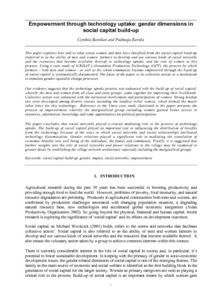Empowerment through technology uptake: gender dimensions in social capital build-up
Abstract
This paper explores how and to what extent women and men have benefited from the social capital build-up (referred to as the ability of men and women farmers to develop and use various kinds of social networks and the resources that become available thereof) in technology uptake, and the role of women in this process. Using a case study of ICRISAT�??s Groundnut Production Technology (GPT), the process by which farmers �?? both men and women - as well as the whole community became empowered through the build-up of social capital is systematically documented. The focus of the paper is on collective action as a mechanism to stimulate gender-equitable change processes. Our evidence suggests that the technology uptake process was enhanced with the build up of social capital, whereby the men and women from all class and caste groups came together for improving their livelihoods. Collective action was enhanced with the increased involvement and participation of women. Strong kinship ties were developed among diverse classes including the landless tribal women, which formed the major labor force for this technology. Reference to the Umra case study illustrated in the paper presents the process of empowerment whereby the marginalized group including women gained better access to resources, information, knowledge and some opportunities for political participation. The paper concludes that social networks played a crucial mediating role in the process of technology uptake. The build-up of social capital played an important role in influencing the distribution of benefits from the technology because of the ways in which social networks and social relationships facilitated technology dissemination. Gender relations played a significant role in mediating the translation of economic benefits into well being of the individual, the family and community. Finally, it is suggested that further insights into the role of social networks and power relations in the village may be examined in greater detail by establishing the village network architecture especially including the marginalized groups

